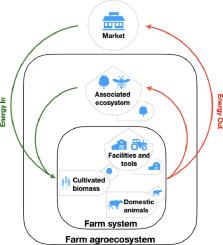Resources, Conservation and Recycling ( IF 11.2 ) Pub Date : 2021-02-21 , DOI: 10.1016/j.resconrec.2021.105502 Jean Hercher-Pasteur , Eléonore Loiseau , Carole Sinfort , Arnaud Hélias

|
An innovative method is described, assessing the energy flows in farm systems. These systems represent both a socio-economic activity and an agroecosystem. Both market and ecosystem flows are inventoried, focusing on farm agroecosystem circularity of the reinvested biomass. An original system representation is proposed, where process and energy storage sub-systems are distinguished. Biotic energy storage, identified as an Associated Ecosystem (AE) is included. Soil mineralization, reflecting soil activity, was selected as a proxy for services provided by the AE. The present approach was tested on an existing French mixed farm case study. Contrasting scenarios were proposed to test the model and the two sets of selected indicators. EROIs (Energy Return On Energy Invest) evaluate the current system performance through resource use efficiency. Circularities reflect the system resilience. (Inflow Circularity) indicates the system self-sufficiency and the extent to which the farm activity is based on the AE. Temporal stability is assessed by the steadiness of the versus (Outflow Circularity) relationship. The Crop production scenario presents best performance. Specialized and intensive systems present lower values. Furthermore, contrasting Circularities were observed for the intensive breeding scenario, while homogenous results were obtained for the extensive mixed-farming scenario. This method takes a new step towards the integration of circularity and ecosystem support functions in the energy analysis of farm systems. Firstly, it provides indicators of performance and resilience. Secondly, as a key feature for sustainable agriculture, it highlights the relationship between agricultural activity and its associated ecosystem.
中文翻译:

识别农业系统中的资源利用和循环性:专注于农业生态系统的能源分析
描述了一种创新方法,用于评估农场系统中的能量流。这些系统既代表着社会经济活动,又代表着农业生态系统。盘点了市场和生态系统流量,重点是再投资生物质的农业生态系统循环度。提出了原始的系统表示形式,其中区分了过程和能量存储子系统。包括被识别为相关生态系统(AE)的生物能源存储。反映土壤活动的土壤矿化被选为AE提供服务的代理。本方法已在现有的法国混合农场案例研究中进行了测试。提出了对比方案来测试模型和两组选定的指标。EROI(能源投资的能源回报)通过资源利用效率评估当前系统的性能。(流入循环性)指示系统自给自足以及场活动基于AE的程度。时间稳定性是通过 相对 (流出圆度)关系。作物生产方案表现最佳。专业化和集约化的系统降低了价值观。此外,在集约化饲养方案中观察到相反的圆度,而在广泛的混合饲养方案中获得了同质的结果。该方法朝着在农场系统的能源分析中整合循环性和生态系统支持功能迈出了新的一步。首先,它提供了性能和弹性指标。其次,作为可持续农业的一个关键特征,它突出了农业活动及其相关生态系统之间的关系。











































 京公网安备 11010802027423号
京公网安备 11010802027423号